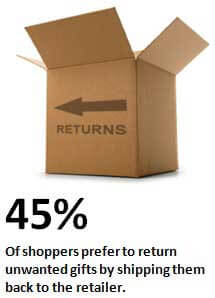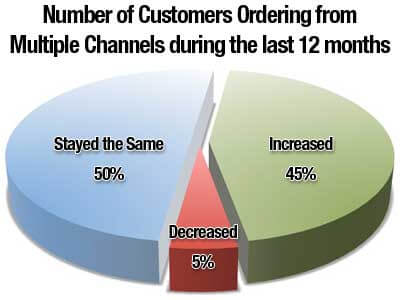5 Key Takeaways From 2013
Takeaway #1 - Expect the Unexpected

When it comes to ecommerce, the exception is now the rule. With online sales consistently experiencing double-digit growth on an annual basis, retailers must be prepared for another significant surge in ecommerce activity.
“Retailers think they can take orders up to the last minute, but they just can’t pick and pack fast enough,” said a spokesperson from Forrester Research.
Giving consumers what they want is important, but it is also critical that brands don’t overpromise and under deliver.
“We think we thoroughly understand the American consumer, but we really don’t,” said Bowen Smith, VP of Sales & Marketing for PFC Fulfillment. “Their behaviors are constantly evolving and can be difficult to react to if you don’t have a sound supply chain process and plan.”
The best way to counteract this is to have a dynamic partner that understands there will be changes and it’s a fluid model. It’s critical for brands to be prepared to quickly react to changes in the marketplace.
Takeaway #2 - Take Control of Returns

Returns are becoming a major headache for brands, as consumers are increasingly empowered by the promise of free returns on all purchases. This year holiday returns jumped 15 percent from 2012, making them a significant challenge and cost for brands.
To counteract this trend, retailers have adopted the strategy of training customers to make better shopping decisions the first time around and help stem buyer’s remorse.
For instance, consumers who typically order two sizes of the same article of clothing knowing they will be returning one of them may receive a pop-up question at checkout questioning whether they really need both sizes. Data mining of purchase history has become a strategic marketing tool to help brands build positive consumer relationships.
Retailers are also emailing consumers detailed instructions on how to use their purchased products in an effort to lessen buyer frustration, which could lead to returns. One brand saw a 30 percent drop in returns and an estimated savings of $55,000 by simply providing additional information on product usage.
However, attempts to curb returns will not make them go away entirely. It is important to have a comprehensive returns policy in place; one that is just as thorough as your order management and fulfillment process.
Takeaway #3 - Deliver on Your Promise
To ease pressure of potential shipping bottlenecks, many big box retailers promoted the option of picking up items ordered online at their brick and mortar store locations. However, these plans backfired for some retailers who couldn’t keep up with demand.
Partnering with a fulfillment company that specializes in multi-channel delivery solutions ensures products are delivered on-time to their desired locations. Sophisticated warehouse management tools allow fulfillment companies to keep detailed reports on inventory min/max levels and have controls in place to trigger orders from the manufacturer when necessary.
Brands who were unable to deliver on their promises found themselves sending gift certificates and waving shipping costs to make up for shortfalls. This can result in thousands to millions of dollars in lost revenue and unsatisfied customers.
“What more and more companies are realizing is that fulfillment is much more than putting items in a box and shipping them,” explained Smith. “Fulfillment partners are in the business of streamlining logistics and saving their clients significant revenue on warehouse, inventory and shipping costs.”
Takeaway #4 - Stay Connected with Consumers

Shoppers have become ultra-savvy when it comes to finding the best deal. Tactics such as “show-rooming,” where shoppers ask detailed questions at retail stores only to return home and buy the same product from different company online, have forced retailers to meet consumers on their turf and engage them at the point of purchase.
Mobile devices are one way to market to consumers immediate needs, but savvy retailers need to deploy a multichannel solution that offers both front end and back end incentives. Consider campaigns that reward shoppers for their loyalty while delivering a superior fulfillment experience that goes beyond their expectations.
Keep in mind that consumers are your most valued asset when it comes to product reviews and feedback. It is critical to engage with them through social channels and reward their loyalty with promotional strategies such as rebates and sweepstakes.
- We think we thoroughly understand the American consumer's behavior, but we really don't. Their behaviors are constantly evolving and can be difficult to react to if you don't have a sound supply chain process and plan.
- Bowen Smith, VP, Sales & Marketing, PFC
Takeaway #5 - Consider a Subscription Business Model
With more and more consumers turning to online shopping for many of their purchases, subscriptions have added yet another level of convenience. Everything from diapers to diet pills can be can be auto shipped to consumers based on their preferences.
This model can be a win-win for both consumers and retailers. The key to execution is having a sophisticated partner with a dynamic order management and warehouse management system in place to ensure timely delivery of product as well as a presentation that exceeds expectations.
“To develop the ideal subscription fulfillment solution it is critical that brands analyze each touch point within the fulfillment chain to identify areas where technology-driven processes can improve results,” said Smith. “PFC works closely with brands to identify these gaps and develop a solution that fully optimizes operations, reduces costs and delivers a flawless customer experience.”
Conclusion

The evidence is clear that more and more consumers are turning to the web for their shopping. Expectations are high when it comes to the promise of free shipping, easy returns and multiple delivery options. Therefore it is incumbent that brands take greater accountability for the promises they make to shoppers to ensure brand loyalty. A good place to start is by asking yourself the following questions:
- Can I operationally handle another double-digit increase in ecommerce orders in 2014?
- Is the returns policy delivering consumer loyalty and cost benefits?
- How can I optimize the multi-channel model?
- Are there any process improvements or new solutions that can be implemented to reduce my cost per order in 2014?
- How can I improve my inventory turns and analysis?
- Should I move to a multiple-ship method model?
PFC Fulfillment has the answers and solutions to these and many other fulfillment challenges.
About Promotions Fulfillment Center
At PFC, our clients’ success is our number one priority. Since 1974, PFC has delivered outstanding results, with turnkey solutions in fulfillment, e-commerce, and contact center – all backed by leading technology.
Brands who partner with PFC have historically achieved considerable cost savings in excess of 35 percent and have significantly improved their turn times.
PFC allows clients to focus on their big picture business goals, while skillfully managing all the details. For more information call (800) 493-7063 or contact us.
Sources: Wall Street Journal, Parcel Industry, Peerless Media Group

